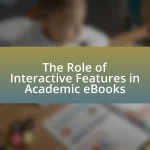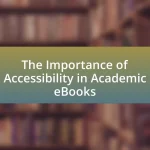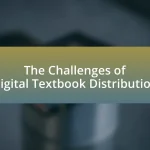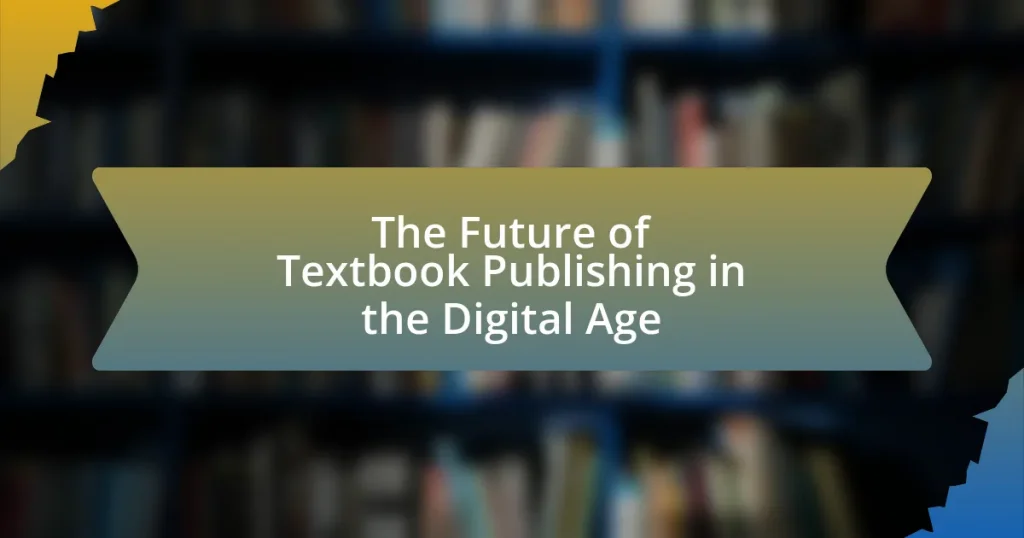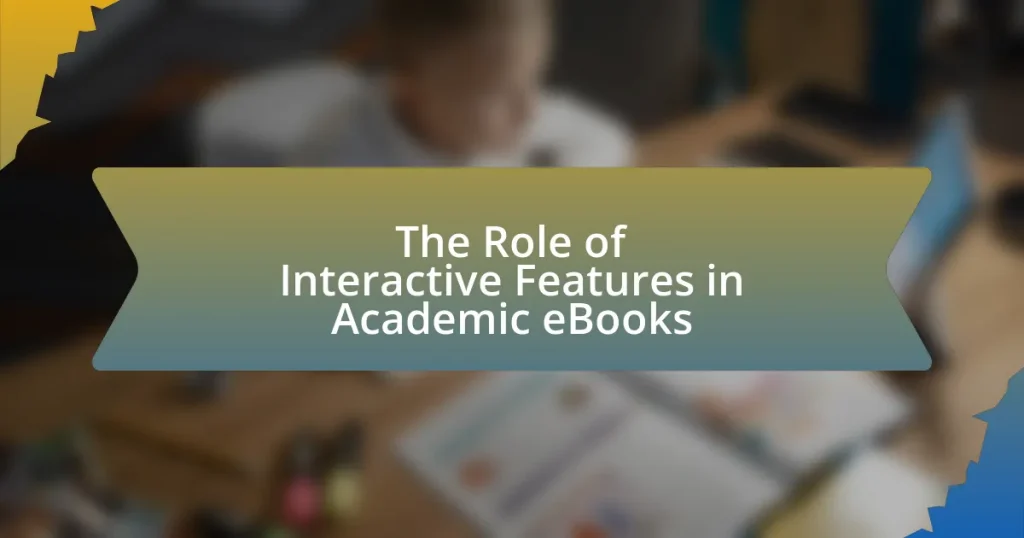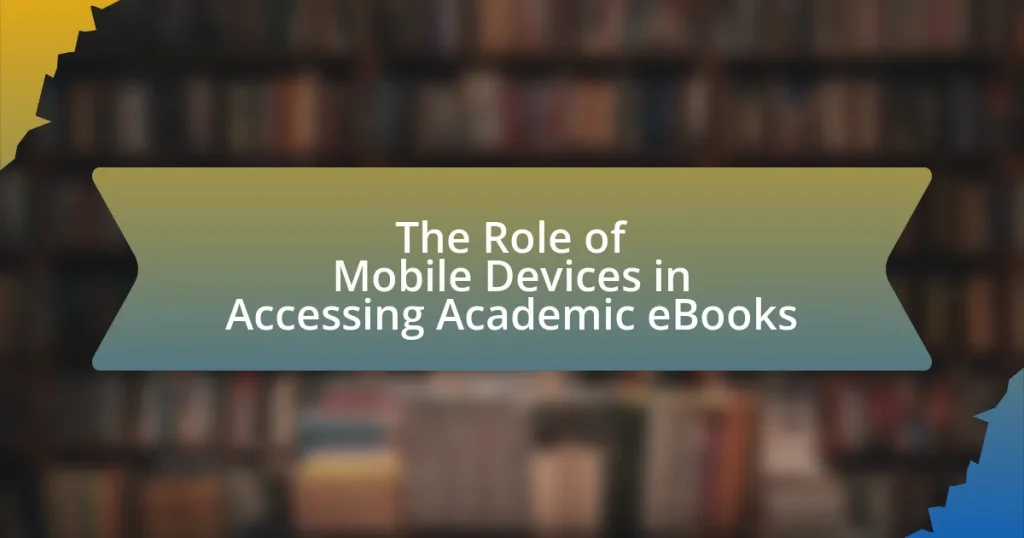The article examines the future of textbook publishing in the digital age, highlighting the transition towards interactive and adaptive learning materials. It discusses the significant growth in digital textbook sales, the impact of open educational resources (OER), and the technological advancements such as artificial intelligence that are reshaping the industry. Key challenges, including copyright issues and the digital divide, are addressed, alongside the opportunities presented by digital formats for enhancing accessibility and engagement in education. The article also explores how educational institutions and publishers are adapting to these changes, emphasizing the importance of data analytics and user engagement strategies in developing effective digital textbooks.
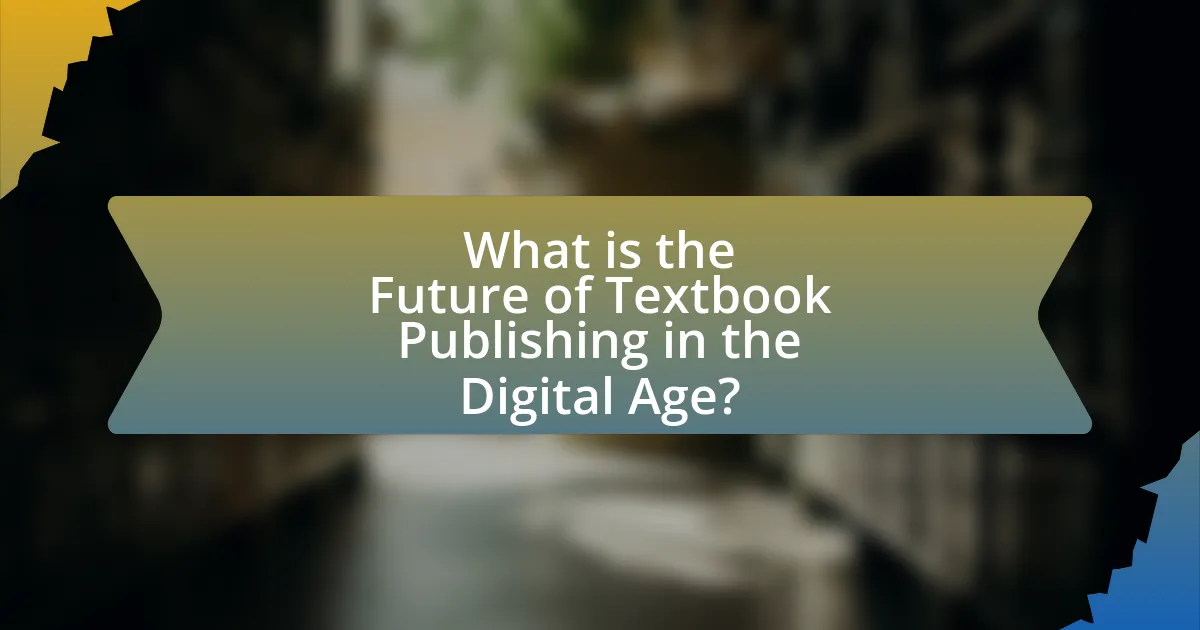
What is the Future of Textbook Publishing in the Digital Age?
The future of textbook publishing in the digital age is characterized by a shift towards interactive and adaptive learning materials. Digital textbooks will increasingly incorporate multimedia elements, such as videos and interactive quizzes, enhancing student engagement and comprehension. According to a report by the National Association of College Stores, digital textbook sales have grown significantly, with a 30% increase in adoption rates over the past five years, indicating a strong trend towards digital formats. Additionally, the rise of open educational resources (OER) is democratizing access to educational materials, allowing for more affordable and customizable options for students and educators alike. This evolution reflects the broader trend of integrating technology into education, making learning more accessible and tailored to individual needs.
How has digital technology transformed textbook publishing?
Digital technology has transformed textbook publishing by enabling the creation and distribution of electronic textbooks, which offer interactive features and instant accessibility. This shift has led to a significant reduction in production costs and time, as digital formats eliminate the need for physical printing and shipping. According to a report by the National Association of College Stores, digital textbooks can be up to 60% cheaper than their print counterparts, making education more affordable. Additionally, digital platforms allow for real-time updates and revisions, ensuring that content remains current and relevant, which is a challenge with traditional print textbooks.
What are the key technological advancements influencing textbook publishing?
Key technological advancements influencing textbook publishing include digital formats, interactive content, and artificial intelligence. Digital formats, such as eBooks and online platforms, have transformed accessibility and distribution, allowing for instant updates and wider reach. Interactive content, including multimedia elements and adaptive learning technologies, enhances engagement and personalization for learners. Artificial intelligence is increasingly utilized for content creation, personalized learning experiences, and data analytics, enabling publishers to tailor materials to specific educational needs. These advancements collectively drive efficiency, accessibility, and customization in the textbook publishing industry.
How do digital formats compare to traditional print formats?
Digital formats offer greater flexibility and accessibility compared to traditional print formats. Digital textbooks can be updated easily, allowing for the inclusion of the latest information and resources, while print textbooks often become outdated quickly. Additionally, digital formats can incorporate interactive elements such as videos, quizzes, and hyperlinks, enhancing the learning experience. According to a study by the National Center for Education Statistics, 70% of students prefer digital formats for their convenience and portability, indicating a significant shift in preference towards digital resources in education.
What challenges does the textbook publishing industry face in the digital age?
The textbook publishing industry faces significant challenges in the digital age, primarily due to the rapid shift towards digital content consumption and the rise of open educational resources (OER). Traditional publishers struggle with declining print sales as educational institutions increasingly adopt digital formats, which offer lower costs and greater accessibility. According to a report by the National Association of College Stores, digital textbook sales grew by 25% in 2020, highlighting the industry’s need to adapt. Additionally, the proliferation of OER, which are freely accessible and openly licensed educational materials, poses a threat to traditional textbook sales, as educators and students seek cost-effective alternatives. This shift necessitates that publishers innovate their business models and invest in digital platforms to remain competitive.
How do copyright issues affect digital textbook publishing?
Copyright issues significantly impact digital textbook publishing by determining the legal rights of authors and publishers over their content. These legal frameworks dictate how digital textbooks can be reproduced, distributed, and modified, influencing pricing, accessibility, and the overall market dynamics. For instance, strict copyright enforcement can limit the availability of affordable educational resources, as publishers may prioritize profit over accessibility. Additionally, the rise of digital formats has led to increased concerns about piracy and unauthorized sharing, prompting publishers to implement digital rights management (DRM) technologies. According to a study by the Association of American Publishers, copyright infringement costs the educational publishing industry billions annually, highlighting the financial implications of these issues.
What are the implications of digital divide on access to textbooks?
The digital divide significantly impacts access to textbooks by creating disparities in educational resources among students. Students without reliable internet access or digital devices are unable to access online textbooks and educational materials, which can hinder their learning and academic performance. According to a report by the Pew Research Center, approximately 15% of U.S. households with school-age children do not have high-speed internet access, limiting their ability to utilize digital textbooks effectively. This inequity can lead to a gap in educational achievement, as those with access to digital resources can benefit from interactive and updated content, while those without remain reliant on traditional, often outdated, print textbooks.
What opportunities does the digital age present for textbook publishers?
The digital age presents significant opportunities for textbook publishers, primarily through enhanced accessibility and interactive content. Publishers can leverage digital platforms to distribute textbooks globally, reaching a wider audience without the limitations of physical distribution. For instance, e-books and online resources can be updated in real-time, ensuring that students have access to the most current information. Additionally, interactive features such as quizzes, videos, and simulations can enhance learning experiences, making textbooks more engaging and effective. According to a report by the National Association of College Stores, digital course materials can reduce costs for students by up to 50%, further incentivizing the shift towards digital formats.
How can publishers leverage data analytics in textbook development?
Publishers can leverage data analytics in textbook development by analyzing student performance data to identify content gaps and areas needing improvement. This approach allows publishers to tailor textbooks to better meet educational standards and student needs. For instance, data from assessments can reveal which topics students struggle with, enabling the creation of targeted supplementary materials. Additionally, analytics can track engagement metrics, such as time spent on specific chapters, helping publishers refine their content for better learning outcomes. Studies have shown that data-driven decisions in educational publishing can lead to a 20% increase in student comprehension and retention rates, demonstrating the effectiveness of this strategy.
What role do interactive and multimedia elements play in digital textbooks?
Interactive and multimedia elements in digital textbooks enhance engagement and facilitate deeper learning. These elements, such as videos, animations, and interactive quizzes, provide diverse ways for students to interact with content, catering to various learning styles. Research indicates that incorporating multimedia can improve retention rates by up to 50%, as it allows learners to visualize complex concepts and apply knowledge in practical scenarios. Furthermore, studies show that interactive features can lead to increased motivation and participation, making the learning experience more dynamic and effective.

How are educational institutions adapting to digital textbooks?
Educational institutions are adapting to digital textbooks by integrating technology into their curricula and providing access to digital resources. Many schools and universities are implementing learning management systems that facilitate the distribution and use of digital textbooks, allowing students to access materials on various devices. For instance, a report from the National Center for Education Statistics indicates that over 50% of postsecondary institutions have adopted digital textbooks in some form, reflecting a significant shift towards digital learning environments. Additionally, institutions are offering training for educators to effectively utilize these resources, ensuring that both faculty and students can maximize the benefits of digital textbooks.
What strategies are schools implementing to integrate digital textbooks?
Schools are implementing several strategies to integrate digital textbooks, including professional development for teachers, curriculum alignment, and infrastructure upgrades. Professional development programs equip educators with the skills to effectively use digital resources, enhancing teaching methods and student engagement. Curriculum alignment ensures that digital textbooks meet educational standards and learning objectives, facilitating a smoother transition from traditional to digital formats. Additionally, schools are investing in infrastructure improvements, such as high-speed internet access and device availability, to support the use of digital textbooks in classrooms. These strategies collectively aim to enhance the educational experience and improve learning outcomes.
How do teachers perceive the effectiveness of digital textbooks in the classroom?
Teachers generally perceive digital textbooks as effective tools for enhancing classroom learning. They appreciate the interactive features, such as multimedia content and instant updates, which can engage students more than traditional textbooks. Research conducted by the University of California found that 78% of teachers reported improved student engagement when using digital textbooks compared to print versions. Additionally, digital textbooks often provide easier access to resources and personalized learning experiences, which teachers believe can cater to diverse learning styles.
What training do educators need to effectively use digital textbooks?
Educators need training in digital literacy, pedagogical strategies for integrating technology, and familiarity with specific digital textbook platforms to effectively use digital textbooks. Digital literacy training equips educators with the skills to navigate and utilize various digital tools and resources, which is essential for engaging with digital textbooks. Pedagogical strategies focus on how to incorporate digital textbooks into lesson plans and assessments, ensuring that educators can enhance student learning outcomes. Familiarity with specific platforms, such as understanding features and functionalities of digital textbooks, allows educators to maximize the benefits of these resources. Research indicates that effective training programs significantly improve educators’ confidence and competence in using digital tools, leading to better educational experiences for students.
What are the implications of digital textbooks on student learning?
Digital textbooks significantly enhance student learning by providing interactive and accessible content. These resources often include multimedia elements such as videos, quizzes, and hyperlinks, which cater to diverse learning styles and promote engagement. Research indicates that students using digital textbooks demonstrate improved retention and understanding of material compared to traditional print textbooks. For instance, a study published in the Journal of Educational Psychology found that students who utilized digital resources scored 20% higher on assessments than those relying solely on printed materials. Additionally, digital textbooks can be updated in real-time, ensuring that students have access to the most current information, which is crucial in rapidly evolving fields.
How do digital textbooks enhance student engagement and learning outcomes?
Digital textbooks enhance student engagement and learning outcomes by providing interactive features that cater to diverse learning styles. These features include multimedia elements such as videos, quizzes, and interactive simulations, which actively involve students in the learning process. Research conducted by the University of California found that students using digital textbooks scored 20% higher on assessments compared to those using traditional textbooks, demonstrating a clear link between digital engagement and improved academic performance. Additionally, digital textbooks allow for real-time updates and personalized learning paths, further supporting student engagement and facilitating better learning outcomes.
What feedback do students provide regarding their experiences with digital textbooks?
Students generally provide positive feedback regarding their experiences with digital textbooks, highlighting benefits such as accessibility, interactivity, and cost-effectiveness. Research indicates that 70% of students appreciate the convenience of accessing materials on multiple devices, which enhances their learning flexibility. Additionally, features like search functions and multimedia content are frequently mentioned as valuable tools that improve engagement and comprehension. A study by the University of Central Florida found that 85% of students preferred digital formats for their ease of use and the ability to annotate directly within the text, reinforcing the notion that digital textbooks significantly enhance the educational experience.

What trends are shaping the future of textbook publishing?
The future of textbook publishing is being shaped by digital transformation, open educational resources (OER), and personalized learning experiences. Digital transformation is leading to the rise of e-textbooks and interactive content, which enhance engagement and accessibility for students. Open educational resources are gaining traction, with institutions increasingly adopting free or low-cost materials to reduce student expenses and promote equitable access to education. Personalized learning experiences are becoming more prevalent as adaptive learning technologies allow for tailored educational pathways, improving student outcomes. According to a report by the Babson Survey Research Group, over 60% of higher education institutions are now using OER, indicating a significant shift towards more accessible educational resources.
How is the rise of open educational resources (OER) impacting traditional publishing?
The rise of open educational resources (OER) is significantly disrupting traditional publishing by providing free and accessible educational materials that challenge the conventional textbook market. Traditional publishers face declining sales as educators and institutions increasingly adopt OER to reduce costs and enhance learning flexibility. For instance, a study by the Babson Survey Research Group found that 60% of faculty members are aware of OER, and 25% have used them in their courses, indicating a shift towards these resources. This trend pressures traditional publishers to adapt their business models, often leading to the development of hybrid offerings that combine OER with proprietary content.
What are the benefits and challenges of adopting OER in education?
The benefits of adopting Open Educational Resources (OER) in education include increased accessibility, cost savings, and enhanced collaboration among educators. OER provides free or low-cost educational materials, which can significantly reduce the financial burden on students; for instance, a study by the Babson Survey Research Group found that 65% of students reported that the cost of textbooks affected their choice of courses. Additionally, OER fosters collaboration, allowing educators to share and adapt resources, which can lead to improved teaching practices and learning outcomes.
However, challenges exist in the adoption of OER, including quality assurance, lack of awareness, and the need for professional development. The variability in the quality of OER can lead to concerns about the effectiveness of these resources, as highlighted by a report from the Institute for the Study of Knowledge Management in Education, which noted that educators often struggle to find high-quality materials. Furthermore, many educators may not be aware of OER or how to effectively integrate them into their teaching, necessitating ongoing training and support to maximize their potential in the classroom.
How do OER compare to traditional textbooks in terms of quality and accessibility?
Open Educational Resources (OER) generally offer greater accessibility and comparable quality to traditional textbooks. OER are freely available online, allowing anyone with internet access to utilize them, while traditional textbooks often require purchase, limiting access for some students. Studies indicate that OER can match or exceed the quality of traditional textbooks; for instance, a study by the University of Georgia found that students using OER performed as well as or better than those using traditional materials in terms of grades. Additionally, OER can be updated more frequently, ensuring that content remains current and relevant, which is often a limitation of traditional textbooks that may not be revised for years.
What role does artificial intelligence play in the future of textbook publishing?
Artificial intelligence will significantly enhance the future of textbook publishing by enabling personalized learning experiences and streamlining content creation. AI algorithms can analyze student performance data to tailor educational materials to individual learning styles, improving engagement and retention. Additionally, AI tools can automate the writing and editing processes, reducing production time and costs. For instance, companies like Pearson and McGraw-Hill are already utilizing AI to create adaptive learning platforms that adjust content based on real-time feedback from students. This integration of AI not only increases efficiency but also ensures that educational resources remain relevant and effective in a rapidly evolving digital landscape.
How can AI personalize learning experiences through digital textbooks?
AI can personalize learning experiences through digital textbooks by analyzing individual student data to tailor content, pacing, and assessments to their unique needs. This personalization is achieved using algorithms that assess a learner’s strengths, weaknesses, and preferences, allowing for adaptive learning paths. For instance, a study by the Bill & Melinda Gates Foundation found that personalized learning approaches can lead to significant improvements in student engagement and achievement, demonstrating the effectiveness of AI-driven customization in educational materials.
What are the potential ethical concerns surrounding AI in education?
The potential ethical concerns surrounding AI in education include issues of data privacy, bias in algorithms, and the impact on teacher-student relationships. Data privacy is a significant concern as AI systems often require access to sensitive student information, raising questions about how this data is collected, stored, and used. Bias in algorithms can lead to unequal educational opportunities, as AI systems may inadvertently favor certain demographics over others, perpetuating existing inequalities. Additionally, the reliance on AI can affect the dynamics of teacher-student relationships, potentially diminishing the role of human interaction in learning environments. These concerns highlight the need for careful consideration and regulation of AI technologies in educational settings.
What best practices should publishers follow in the digital age?
Publishers in the digital age should prioritize content accessibility, user engagement, and data analytics. Ensuring that digital textbooks are compatible with various devices and platforms enhances accessibility, allowing a broader audience to access educational materials. Engaging users through interactive content, such as quizzes and multimedia elements, increases retention and learning outcomes. Furthermore, leveraging data analytics enables publishers to understand user behavior and preferences, allowing for tailored content that meets the needs of diverse learners. According to a report by the National Association of College Stores, 70% of students prefer digital formats for their convenience and accessibility, underscoring the importance of these best practices.
How can publishers ensure the quality and relevance of digital textbooks?
Publishers can ensure the quality and relevance of digital textbooks by implementing rigorous content review processes and incorporating feedback from educators and students. This involves establishing a team of subject matter experts to evaluate the accuracy and comprehensiveness of the material, ensuring it aligns with current educational standards. Additionally, publishers can utilize analytics to track user engagement and learning outcomes, allowing them to adapt content based on real-time data. Research indicates that textbooks that undergo continuous updates and revisions based on user feedback are more effective in meeting educational needs, as seen in studies conducted by the National Education Association, which highlight the importance of responsive content in enhancing student learning experiences.
What strategies can be employed to engage users and enhance their experience?
To engage users and enhance their experience in the context of digital textbook publishing, interactive content strategies should be employed. These strategies include incorporating multimedia elements such as videos, quizzes, and interactive simulations that cater to diverse learning styles, thereby increasing user engagement. Research indicates that interactive learning can improve retention rates by up to 75%, as highlighted in a study by the University of Colorado Boulder, which found that students who engaged with interactive materials performed significantly better than those who used traditional textbooks. Additionally, personalized learning pathways that adapt to individual user progress can further enhance the experience, as they provide tailored content that meets specific educational needs.
